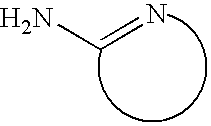Bulk manufacturing of supramolecular polymer forming polymer
a polymer and supramolecular technology, applied in the field of polymer, can solve the problems of poor mechanical properties and tendency to crystalliz
- Summary
- Abstract
- Description
- Claims
- Application Information
AI Technical Summary
Benefits of technology
Problems solved by technology
Method used
Image
Examples
example 1
[0045] Prepolymer 1 was prepared by stirring a mixture of 73 pbw of a polypropyleneoxide (PPG2000) having a nominal functionality of 2 and nominal MW 2000 together with 27 pbw SUPRASEC® MPR isocyanate at 87° C. under nitrogen for three hours. After cooling, the prepolymer was stored as a masterbatch under nitrogen.
[0046] A pre-calculated amount of 1,4-butanediol BD ( 50wt % solution in dimethylacetamide) was added dropwise over a period of 20 minutes to a known amount of a stirred 50wt % dimethylacetamide solution of the prepolymer at 87° C. under nitrogen and the heating / stirring were maintained for a further 3 hours. A dimethylacetamide solution of the desired end-capping compound was added to the stirred reaction mixture at 87° C. and the reaction conditions were maintained for a further 3 hours. After cooling, the TPU or TRPU was isolated by casting at 50° C. in a vacuum oven or by precipitation of a 30wt % dimethylacetamide solution into a four-fold (by mass) excess of a non-s...
example 2
[0058] Prepolymer 1 was synthesized according to the procedure described in Example 1. A pre-calculated amount of a 50wt % solution of SUPRASEC® MPR isocyanate (Table 3) was then added to a stirred 50wt % dimethylacetamide solution of Prepolymer 1 at 87° C. under nitrogen and the reaction continued for 3 hours. In the case of Polymer 2A, a dimethylacetamide solution of 6-methylisocytosine was added and the resultant reaction mixture heated with stirring at 87° C. for 3 hours. After cooling, the polymer was isolated by casting at 50° C. in vacuo. The following table 4 gives the weight composition.
TABLE 4pbw SUPRASECMPRSamplePbw PPG2000isocyanatepbw melso2A83.714.81.52B83.716.30
example 3
[0059] Prepolymer 3 was prepared by stirring a mixture of 78.6 pbw of a polyadipate ester (DALTOREZ P765 ester) having a nominal functionality of 2 and nominal MW 2200 together with 21.4 pbw SUPRASEC MPR isocyanate at 87° C. under nitrogen for three hours. After cooling, the prepolymer was stored as a masterbatch under nitrogen.
[0060] A pre-calculated amount of 1,4-butanediol (50wt % solution in dimethylacetamide) was added dropwise over a period of 20 minutes to a known amount of a stirred 50wt % dimethylacetamide solution of the prepolymer at 87° C. under nitrogen and the heating / stirring were maintained for a further 3 hours. A dimethylacetamide solution of the desired end-capping compound was added to the stirred reaction mixture at 87° C. and the reaction conditions were maintained for a further 3 hours. After cooling, the TPU or TRPU was isolated by casting at 80° C. in an oven. The formulations of the resultant TPUs and TRPUs are given in Table 5.
TABLE 5End-Cappingpbwpbw E...
PUM
| Property | Measurement | Unit |
|---|---|---|
| particle size | aaaaa | aaaaa |
| temperature | aaaaa | aaaaa |
| temperature | aaaaa | aaaaa |
Abstract
Description
Claims
Application Information
 Login to View More
Login to View More - R&D
- Intellectual Property
- Life Sciences
- Materials
- Tech Scout
- Unparalleled Data Quality
- Higher Quality Content
- 60% Fewer Hallucinations
Browse by: Latest US Patents, China's latest patents, Technical Efficacy Thesaurus, Application Domain, Technology Topic, Popular Technical Reports.
© 2025 PatSnap. All rights reserved.Legal|Privacy policy|Modern Slavery Act Transparency Statement|Sitemap|About US| Contact US: help@patsnap.com



